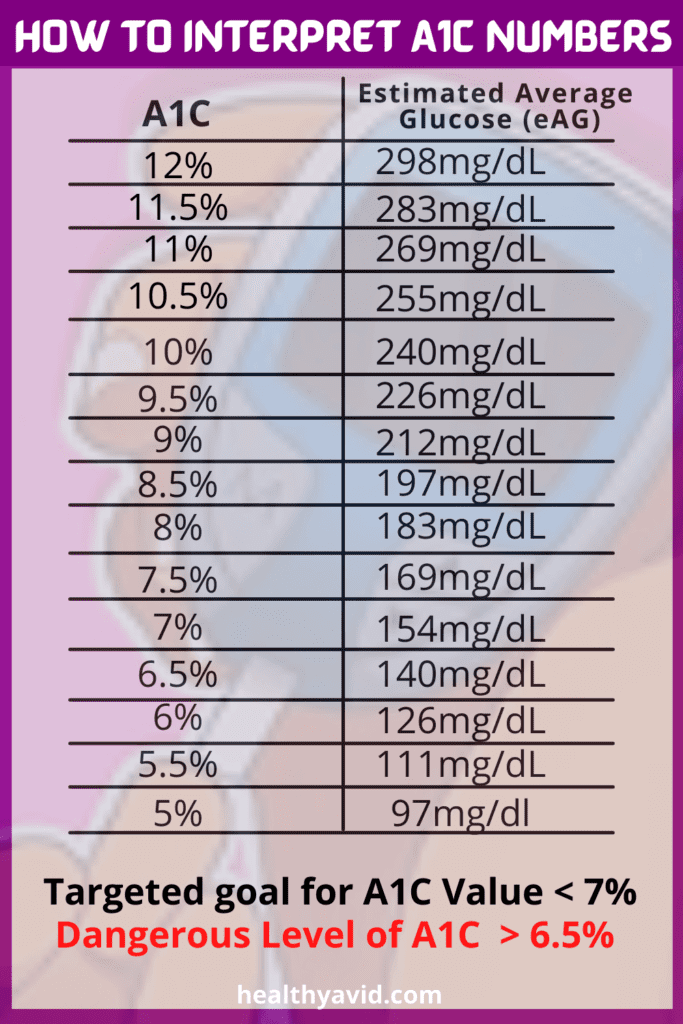Last Updated on June 23, 2025 by Lauretta Iyamu, PharmD
The current diabetes statistics are increasing. According to the latest Centers for Disease Control (CDC) research, about 37.3 million Americans live with diabetes, and 96 million American adults have pre-diabetes. You can begin enjoying this by knowing the most important number in diabetes diagnosis, ‘Hemoglobin A1C’. Read more about “Diabetes blood sugar chart: how to interpret A1C Numbers” in this article. Whether you are newly diagnosed or have been a person with diabetes for a long while, tracking your blood sugar is very helpful.
Blood Sugar Chart a1c
The report also shows that newly diagnosed cases of Type 1 and Type 2 diabetes are rising among American youths. In adults, there is much room for improvement in preventing diabetes complications. As you continue to talk about the diabetes epidemic more often and increasingly, you are creating better support for those with diabetes. Instead of feeling overwhelmed or paralyzed with fear, you can approach a diagnosis with confidence and control because you can educate and equip yourself with the right resources you need to live and thrive with diabetes.
However, it is essential to know that tracking your blood sugar is very important even when you are following healthy lifestyle habits to maintain your blood sugar. If you need to keep good track of your blood sugar at any time of the day, week, or even month, you sure need this chart as a reference. You should use this blood sugar chart as a reference to check your blood sugar when you wake up, before and after meals, and at bedtime.
- Fasting blood sugar before a meal: 90 – 130mg/dl
- Blood sugar after a meal (2hour after your first bite of a meal) > 180mg/dl
- Blood sugar at Bedtime: 100 – 140mg/dl
Another way you can check your blood sugar is via the hemoglobin A1C test. Understanding the hemoglobin A1C is the most important number to know in diagnosis.
Hemoglobin A1C is the average daily blood sugar level over the past two to three months. It is also called HbA1c, glycated hemoglobin test, and glycohemoglobin.
Hemoglobin A1C helps measure the amount of sugar attached to your red blood cells. Knowing these Hemoglobin A1C numbers gives you and your doctors an idea see if you need to adjust your diabetes medications.
What is Hemoglobin?
Hemoglobin is a protein found only in red blood cells. It gives blood its bright red color. The main job of hemoglobin is to carry oxygen throughout the body from your lungs.
How does HbA1C Work?
The red blood cells live an average of three months. Therefore, the A1C test gives a percentage of the red blood cells in the bloodstream at the testing time. Hence, A1C serves as an average of blood sugar control.
How Often Should The A1C Test Be Carried Out?
Hemoglobin A1C levels should be measured twice a year in a stable person with diabetes and at least four times in a person whose blood sugar is fluctuating or who has had a change in their diabetic treatment.
What is the Normal HbA1C Test?
For an A1C test to be considered normal;
- In a non-diabetic, the value must be below 5 to 7 percent
- In a pre-diabetic HbA1C value is 5.7 to 6.4 percent
- In a diabetic HbA1C value is 6.5 percent or greater

What should be a target goal for A1C LEVEL?
For diagnosed diabetics, the targeted goal for A1C level is often less than 7 percent. A dangerous level of A1C would be a value greater than 6.5 percent. At this point, the amount of blood sugar is very high and can result in diabetes complications and nerve and organ damage.
What Factors Can Interfere with A1C Test?
Some of these interfering factors that can affect HbA1C test results include;
- Inaccurate results: Disease conditions such as sickle cell anemia, kidney disease, liver disease, anemia, Thalassemia, drugs (immunosuppressant)
- False low A1C Value: Pregnancy, bleeding, kidney disease, liver disease, anemia, alcohol, folic acid deficiency.
- False High A1C value: Iron deficiency in the blood
Conclusion
Prevention of diabetes is possible, and the first step is awareness. Combining exercise, diet, and drugs can help you reduce your blood sugar levels. You should have your HbA1C checked every three months yearly to determine if your blood sugar is within the target level. To ensure you’re getting the correct A1C value, you must know the causes of false-positive and false-negative results. Hemoglobin A1C is an essential tool in the fight against diabetes.
Sharing is caring: Did you like this article? Kindly Share or Save THIS PIN to your Diabetes Pinterest board
Reference
- National diabetes statistics report | diabetes | cdc [Internet]. 2022 [cited 2022 Dec 21]. Available from: https://www.cdc.gov/diabetes/data/statistics-report/index.html
- Eyth E, Naik R. Hemoglobin a1c. In: StatPearls [Internet]. Treasure Island (FL): StatPearls Publishing; 2022 [cited 2022 Dec 21]. Available from: http://www.ncbi.nlm.nih.gov/books/NBK549816/









































